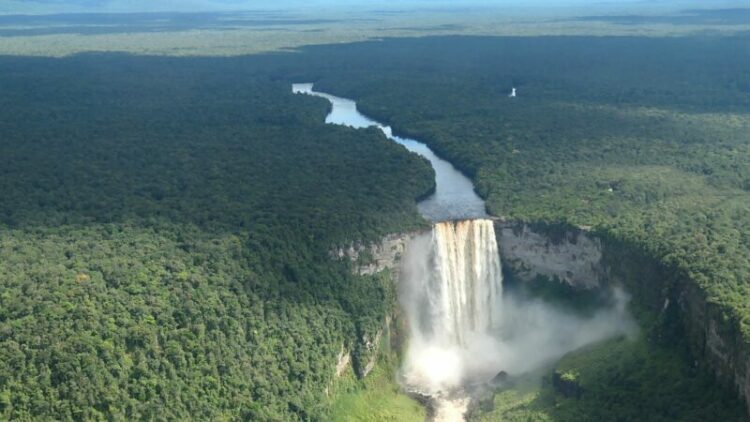Image of Guyana’s Kaiteur Falls via Canva Pro.
By Tyrell Gittens
This story was first published on the Cari-Bois Environmental News Network. An edited version appears below as part of a content-sharing agreement.
Talk about climate change must be followed by climate action — this was the message to participants of the recently concluded 26th RedLAC Congress, which took place in St. Lucia from October 7–10. In keeping with the Kunming-Montreal Global Biodiversity Framework, action is especially important when it comes to regional projects that help attain the conservation of 30 percent of the region’s biodiversity by 2030.
Guyana’s Senior Director of Climate Change Pradeepa Bholanath explained that while her country’s Low Carbon Development Strategy is being used as a tool to support economic growth with low carbon activities, it is also the result of extensive research on the country’s flora, fauna, watersheds, and forest carbon.
Guyana, one of the pioneers in forest monetisation, established a decade-long memorandum of understanding (MoU) with Norway from 2010–2020, worth an estimated USD 220 million in financing for Guyana’s low carbon development strategy, with performance indicators against key biodiversity targets.
“One of those key indicators,” Bholanath said, “was maintaining forest cover, and maintaining intact forests.” Guyana defines intact forests as contiguous unbroken blocks of 50,000 hectares or more, which “ensures the protection of biodiversity corridors, key watersheds, and Indigenous peoples who live within those areas and enjoy the pristine nature of the forests.”
This produces a ripple effect. The protection of forests helps conserve biodiversity, and ensures that communities dependent on these ecosystems are able to maintain both a decent standard of living and access to the resources they are stewards of.
This type of stewardship becomes even more important in the context of Guyana’s newly discovered oil reserves, as it requires a vision for development and implementation “that is low carbon in nature” and aligned with the 2030 vision.
“Expanding protected areas, climate change mitigation and adaptation goals that have to do with carbon markets [and] climate financing,” Bholanath added, should all be taking shape by then. To that end, Guyana has been working on expanding collaborations to include more non-governmental organisations (NGOs) and private-sector groups like the World Wildlife Fund and Conservation International Guyana, which she described as “one of the driving forces” fostering community-level participation and supporting the expansion of protected areas in the country.
Several Indigenous communities have become involved in Guyana’s climate finance programme, but to see such community-level actions have an impact, they must be financed, and the German Development Bank has committed to financing biodiversity conservation efforts in Latin America and the Caribbean.
Jens Mackensen, head of the bank’s Latin America Division of Biodiversity and Sustainable Resource Management, said they are specifically aiming to provide blended financing models that are compatible with the region’s varying conservation needs. This approach, he added, is “a very good tool to ensure that public financing is combined with local efforts and local financing in order to achieve more scale,” and have a larger impact.
Mackensen believes that the successful implementation of the global biodiversity framework will involve cooperation between international financial institutions and local conservation trust funds when it comes to financing projects. As for implementation, however, local communities must take the reins. Not only does this help people become more invested in the outcome, but it also creates active spaces for developing new ideas.
To this end, the Caribbean Biodiversity Fund launched its fifth call for proposals at the RedLAC Congress under its ecosystem-based adaptation facility (EbA). The Fund, which has yielded several impactful projects thus far, supports projects that are focused on conservation and ecosystem services for livelihood and climate adaptation.
One project that stood out to the Fund’s manager, Ulrike Krauss, was done in conjunction with the Inter-American Institute for Cooperation on Agriculture (ICA). In conjunction with the private sector, they successfully worked with a quarry operator that was causing sediment runoff and contaminating a reef. Part of the solution to the problem was planting vetiver grass along the sedimentation pond to filter out the sediment.
With regional environmentalists and international funders now actively trying to work together, she hopes there will be many more.
Tyrell Gittens is the coordinator and editor for the Cari-Bois Environmental News Network.
Source link : http://www.bing.com/news/apiclick.aspx?ref=FexRss&aid=&tid=671c149f4c1847d0845c4e248e6346b0&url=https%3A%2F%2Fglobalvoices.org%2F2024%2F10%2F15%2Fhow-guyana-is-striving-towards-the-30×30-conservation-target%2F&c=7959686888301109896&mkt=en-us
Author :
Publish date : 2024-10-15 10:35:00
Copyright for syndicated content belongs to the linked Source.
